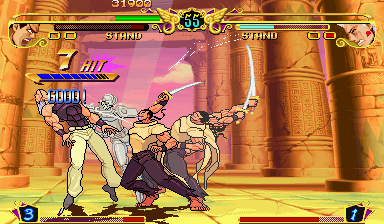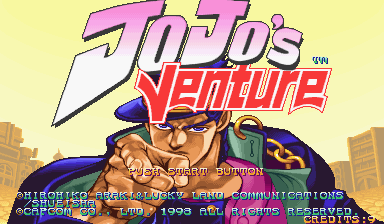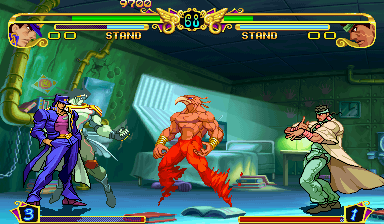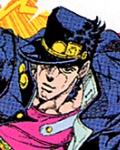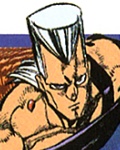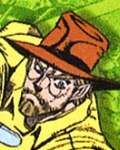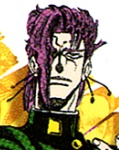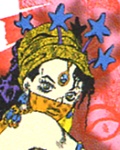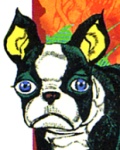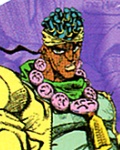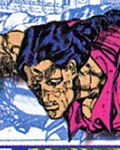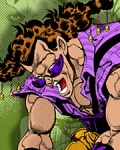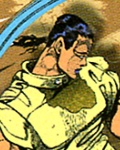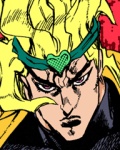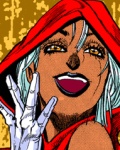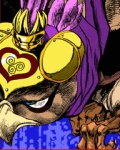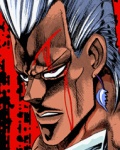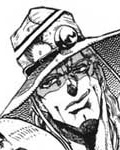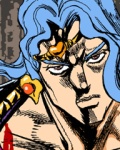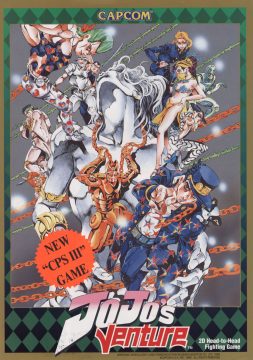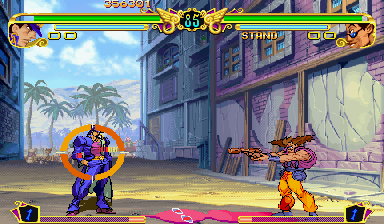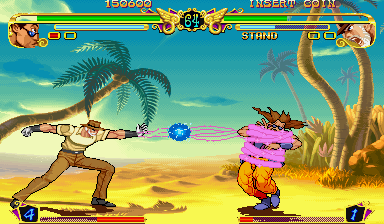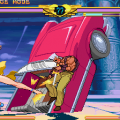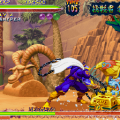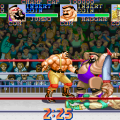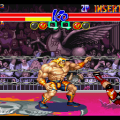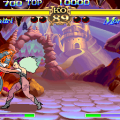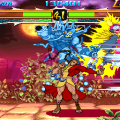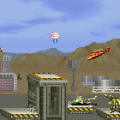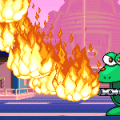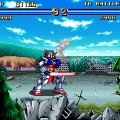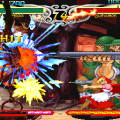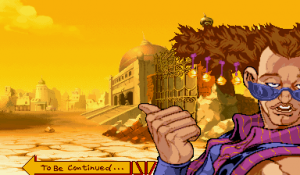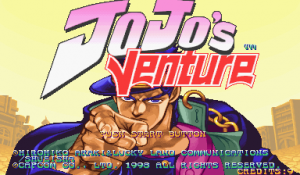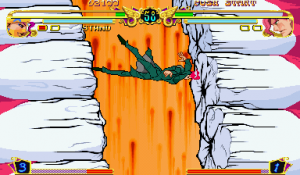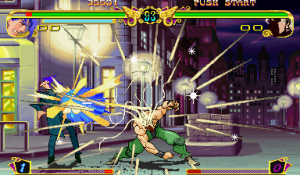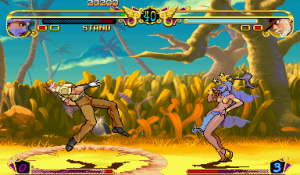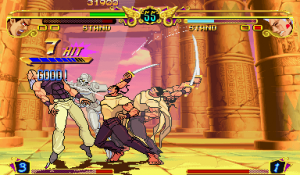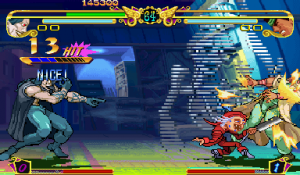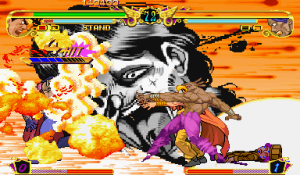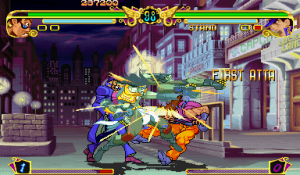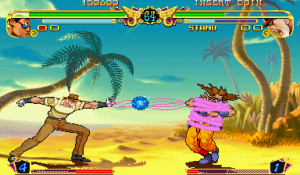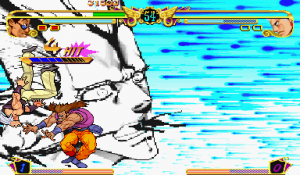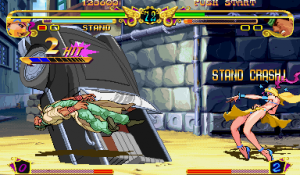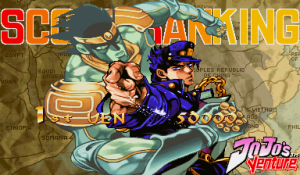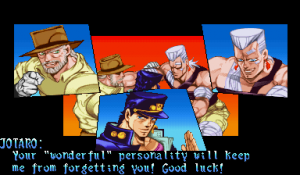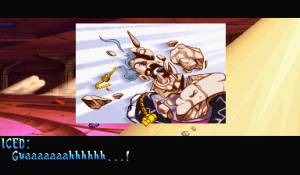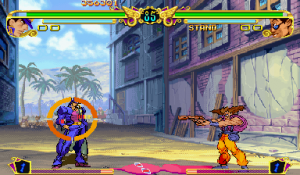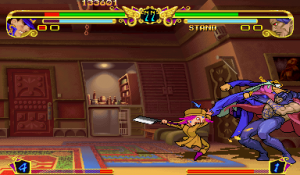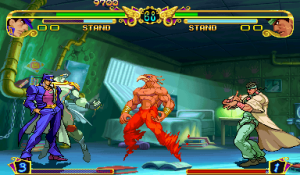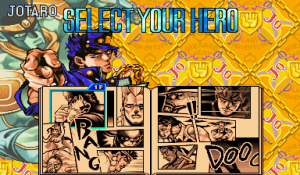After a string of hit 2D fighting games on the CPS-2 system (namely the Street Fighter, Alpha and Darkstalkers games), Capcom introduced its next (and final) generation of 2D arcade hardware in 1998. This would be known as the CPS-3 system.
The CPS-3 opened with Red Earth (Warzard). While Red Earth showcased impressive technology, boasting stunning visuals that far surpassed previous Capcom arcade games, it would only be a mild success, just like the board itself. In fact, the series that the CPS-3 board has become known for among its six total games are the Street Fighter III series which culminated in the critically acclaimed Street Fighter III: Third Strike. However, this article is about two little known unique fighting games for the CPS-3, JoJo’s Venture & JoJo’s Bizarre Adventure.
Four years prior, in August 1992, Hirohiko Araki would finish the third part of his phenomenal hit manga JoJo’s Bizarre Adventure: Stardust Crusaders. It would star Jotaro Kujo and his grandfather Joseph Joester along with a group of comrades in their quest to defeat the evil Dio. Dio has been the arch-nemesis of the Joester’s for over 100 years. (This is covered in full in the first two parts of the manga.) The characters in JJBA:SC do battle using so-called Stands: spirits or powerful visions created by the users life energy. It is these stands and this arc of the manga on which the CPS-3 fighting games are based.
The game series had a star-studded development team, including notable Capcom staff such as Obata Shinichiro as planner (who would later work on Marvel Vs Capcom 2) and Noritaka Funamizu (of Street Fighter fame). JoJo author Hirohiko Araki also served as a consultant for the game. The series was developed by the team responsible for the Street Fighter 3 series.
So, with the team in place, the JoJo’s Bizarre Adventure series was ready to begin. Before even playing any of the games in the series, just by looking at them, the vibrant and unique art style of Araki’s work is instantly visible. Characters are big, bold, and colorful, their designs bursting with variety. Unconventional most certainly, but it makes for a more interesting cast than the generic martial artists of other fighting games at the time. No character looks ordinary and predictable; the fighters’ different Stands also ensure that every character is unique and instantly recognizable. There are no shotoclones here.
Just glancing at the character select screen, you have a fighting dog, an ass-kicking old man, a belly dancer, and a serial killer whose weapon of choice is a talking dummy. With such a cast, JoJo instantly sets itself apart from the rogues’ galleries of other fighting games of the time. Something must also be said for the accuracy and authenticity with which Capcom brings Araki’s characters into the game with an effect of them leaping off the page in a style identical to the manga.
The series also has fantastically smooth animations. Even when the characters are just standing, they ooze personality. The smallest physical changes bring the characters to life as they control their Stands. For example, Kakyoin has his flashy and flamboyant posture in contrast with Jotaro’s gruffer, intimidating manner. The animations of the Stands themselves are also incredibly well done, with smooth and uninterrupted movements.
The soundtrack of the series is also notable, as it is one of the more underrated ones in Capcom’s history. The heroes’ themes are fitting, and, well… heroic. Polnareff’s sounds like a Mega Man X or VS game soundtrack with quite an upbeat tempo. The real strength of the soundtrack, however, lies in the themes for the villains. There is a perfect blend of atmospheric and ambient music. Few of the themes are as fast-paced as that of typical fighting games, with Dio, Chaka and Midler’s themes sounding far more relaxed, yet dark and mysterious. The other key compositions in the series are the raw intensity of Vanilla Ice’s (Iced) theme (which is perfect boss music) and the strange and unsettling themes of Devo (or D’Bo), Alessi and Death 13. These fit perfectly not only in terms of characterization, but the supernatural and suspenseful elements of the series.
Being a Capcom fighting game, anyone who is familiar with Street Fighter or Darkstalkers will know exactly what to expect when going into the JoJo series. The gameplay is fast paced, relying on speedy quarter back circle motions. There are the usual light, medium and heavy attacks, as well as a super meter which allows for – you guessed it – super moves.
JoJo does have some innovation in its mechanics, however, which comes with the Stand button. Along with your health meter you are presented with a Stand meter, which operates similarly to a guard meter. Every time a Stand is attacked the meter goes down until it is gone. The stand is then “Stand crushed”, which renders them inactive for a short time. You can however restore this meter by deactivating your Stand.
The reason this is the key to combat in JoJo is twofold: Not only do the Stands take less damage than their users, but they also enhance the range of special moves and deal out far more damage. In some cases they can even be separated from the user and are allowed to move on their own as a separate character. This creates an interesting balance between attacking and defending with both your character and the Stand, making for a slightly unconventional twist on the ordinary fighting game formula. JoJo also has a few smaller innovations such as a roll button, attack clashes, guard cancels, custom combos, and button mashing sequences (when equal attacks meet) to differentiate itself from the traditional fighting game.
The second key mechanic JoJo introduces is the tandem attack, of which there are two types: The first is the Program Attack, where the individual Stand performs the super move input by the player. The second is the Real Time Attack where, much like the custom combos of Street Fighter Alpha 2, the player taps a series of buttons and the attacks pushed are linked into a combo. So while JoJo is not the deepest fighter around, there is a variety of techniques to provide some depth for the hardcore fighter fan.
JoJo works so well because all its parts fall into place perfectly, where it takes the firmly established mechanics of Capcom’s previous games like super bars, the button layout and motions, and then adds little twists in the form of the Stand, clashes and custom combos to distance it from the everyday fighter. On top of that, it is one of the few fighting games where style and substance both excel equally. Characters are visually unique and have stronger narratives and backgrounds than the typical fighting game heroes. But JoJo is a competent fighting game in its own right, regardless of license or developer reputation.
The JoJo games are fun, stylish and fast paced fighters. They are also vastly underrated in comparison to their genre contemporaries. The series is also significant in that the 2nd game is the last game produced on CPS-3 hardware (and by extension Capcom proprietary hardware before they moved onto Taito boards). JoJo also has characters that are brimming with personality and charm, from the valiant Polnareff to the utterly repulsive Dio.
Even on its own, JoJo is significant because it gave Capcom a chance to refine all it had perfected with its previous fighting games. It also allowed Capcom to take a license just quirky enough for them to put an unconventional twist on the genre. It also manages to be a fantastic fighting game in its own right.
Links:
JoJo’s Bizarre Encyclopedia is a fantastic resource for everything JoJo related.
Characters
Jean Pierre Polnareff
A chivalrous and gallant Frenchman, Polnareff joins Jotaro and the rest of the Stardust Crusaders to find the man who killed his sister. He comes complete with a Vanilla Ice haircut, and was also the inspiration for the SNK King of Fighters character Benimaru.
Noriaki Kakyoin
A quiet and slightly introverted character that came into contact with Dio and was made into his slave after discovering his Stand powers. Rescued by Jotaro, he now hunts Dio to overcome his fears.
Iggy
A dog with a taste for coffee flavoured chewing gum that lived on the streets of New York. His Stand is The Fool which attacks by hurling sand at the enemy.
Devo the Cursed (D’Bo)
Devo is a serial killer who kills his victims by cursing them. He also has the ability to use Native American magic. His stand is Ebony Devil, a psychotic Chucky-esque doll.
Chaka (Chaca)
An innocent young farmer, Chaka accidentally finds and picks up the Anubis sword, which then leads to its Stand taking control of him. He now endlessly searches for any opponents to kill, doing Anubis’s bidding.
Dio
The main villain of both the games and the first and third parts of the manga, Dio’s life goal is to be the most powerful being in existence. After putting on the stone mask in the first part of the manga, Dio turned into a vampire only for his plans of world domination to be thwarted by the original JoJo, Jonathan. Now, after 100 years Dio returns to once again try to take over the world. But first he must exact his revenge on the Joestars.
Mariah
One of the many femme fatales of JoJo, Mariah serves Dio, as she (like many other people) is completely charmed by him. Her Stand is Bast, which magnetically charges opponents, and her attacks involve throwing metal objects at her enemies.
Black Polnareff
This is Polnareff when he accidentally picks up Anubis, which leads to him being temporarily controlled by the Stand. He wields both Polnareff’s original stand Silver Chariot as well as Anubis, making him into a dual weapon swordsman.
Vanilla Ice
Dio’s incredibly loyal second-in-command, Vanilla Ice will stop at nothing to help Dio. Whenever his master is besmirched or insulted he goes into a blind rage. He is even willing to cut his head off for Dio. He is also turned into a vampire. His stand is Cream, which turns itself into a black void to consume space & time.
The first JoJo game is an impressive debut, introducing the gorgeous visual style and animation that the series would be known for. Capcom did a great job of capturing the source material perfectly. From the very start with the voice acting of Jotaro (provided by Kiyoyuki Yanada) and the character select screen depicted as a manga panel, the game reeks of authenticity towards the source material.
The story introductions for the characters in arcade mode are likewise accompanied with redrawn and coloured panels from the manga, a very distinct presentational choice. (The translation for the English version is slightly censored.) It would however have been preferable to have speech to go along with the text. This would then complete the transformation from the manga into a full-blown video game adaptation. With voice being present throughout the rest of the game, you would think this would be a natural conclusion.
The roster may be a little on the small side with only twelve characters total (two of which are unlockable but not all that different), but there is a variety in play style between most of the selectable core characters. Some may find the secret characters disappointing, as both of them are based on already playable characters just with some slight alterations.
One key character of note is the character of Midler. She is shown in the manga as a body with no visible face for a grand total of two panels. Per Capcom’s request, Arak then developed the character design fully. Fast forward to the game and Midler has turned into a belly dancer with an all new character design specifically for this game.
In fact, the level of fan service within the game is outstanding. A variety of easter eggs for long time fans of the series fill the game at every opportunity. Beyond the individual characters all having story modes, Capcom placed little individual touches, like Joseph Joester’s infamous “OH MY GOD” line. The references also get more obscure and hardcore throughout the game. For example, Alessi’s technique turns opponents into virtually unknown side characters, showing just how much Capcom pulled from the source material. This level of fan service also carries over to the presentation of the game, with Japanese graphical “sound effects” ripped directly from the manga during special attacks, tarot cards for each Stand during story mode and D’arby sealing souls into poker chips on the continue screen.
Something must also be said for the authenticity of the characters in the game. Rather than Capcom making up their own moves and techniques (as is common with many anime and other licensed games), every attack, every taunt is lifted directly from the manga, creating a faithful and legitimate JoJo experience.
There are a few issues with the game. First, some may find the arcade mode a little easy as the regular cast are not that difficult to dispose of. The sub-boss Vanilla Ice (Iced in the English version), however, is very cheap towards newcomers, because of his strong attacks which come out of nowhere and leave him virtually invulnerable. Once you get the hang of the attack patterns, though, he is relatively easy to defeat.
The cut scenes, while well animated, do not have much in the way of action or movement. They just narrate events pre and post fight, leaving the vast majority of them to be filled with conversation. This means that while they are presented well, they can be slightly wooden and uninteresting.
Overall, JoJo’s Venture is a solid 2D fighter based on the classic Capcom Street Fighter gameplay, which makes it very playable even 10 years later. On top of that, its characterization is strong and distinct from most other fighters, making for a very unique fighting game.
